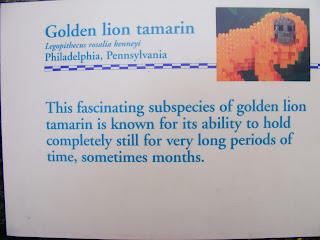EDIT: Recent studies by
Dr. Anna Nekaris and her team have shown that slow lorises are both poisonous AND venomous (how interesting!). It has came to my attention that this blog post is being used by those to argue for the suitability of slow lorises as pets. I concluded that slow lorises are not poisonous, but could be venomous, citing lack of evidence. However, this has since been proven incorrect with evidence to support that
slow lorises are BOTH poisonous and venomous.
Just to make one thing very clear,
I do not condone keeping nonhuman primates as pets.
I passionately plea that you
do not purchase or keep slow lorises as pets. Slow lorises do not make good pets and the pet trade that brought these lorises to you are cruel and unsustainable.
Please read this post on why we need to not support slow loris pet trade.
- Prancing Papio
*****************************************************************************
I must say, the idea of venomous primates never crossed my mind. While venomous species do exist in mammals, it is much more common in insects, reptiles and fishes. In primates, slow lorises (genus
Nycticebus) are thought to be venomous in Thai folklore (Wilde, 1972) but are they really?
Nycticebus

As of 2010, the genus
Nycticebus consists of four species: Pygmy slow loris (
Nycticebus pygmaeus), Javan slow loris (
Nycticebus javanicus), Sunda slow loris (
Nycticebus coucang) and Bengal slow loris (
Nycticebus bengalensis). The Javan slow loris was previously recognized as a subspecies but has since been elevated to species status. These prosimians are found in different parts of Southeast Asia.
Nycticebus range, in red. Illustration from Primate Info Net.

Slow lorises are arboreal primates that move quadrupedally between branches. They are nocturnal and omnivorous, feeding on plant matter and insects. Slow lorises sleep during the day, curled up like a ball in hidden parts of trees above ground. Their predators include pythons (
Python reticulatus), hawk-eagles (
Spizaetus cirrhatus) and orangutans (
Pongo pygmaeus). Slow lorises have a relatively low metabolism compared to similar-sized mammals (Gron, 2009).
Sunda slow loris (Nycticebus coucang). Photo from Primate Info Net.
Colors and markings in
Nycticebus species and subspecies. Illustration from
Loris Conservation.
Venomous vs. Poisonous
Although the words "venomous" and "poisonous" are used interchangeably in everyday speech, they are actually fundamentally different. By definition, venom has to be injected into the body, introduced by a bite or a sting. Poison, on the other hand, is ingested or inhaled into the body by the victim. Thus, venomous and poisonous animals are altogether different.
The blue dart frog (Dendrobates azureus) is a poisonous animal while the Indian cobra (Naja naja) is a venomous animal.
Brachial gland of slow lorises
The flexor surface or the ventral side of the elbow has a slightly raised but barely visible swelling termed the brachial gland (Hagey et al., 2006; Krane et al., 2003). Observations from captive slow lorises show that when the animal is disturbed during handling, they secrete about 10 microliters (μL) of clear, strong-smelling fluid in the form of an apocrine sweat (exudate) from their brachial gland . Usually, male and female slow lorises assume a defensive stance when disturbed. They bend their heads downwards between uplifted forelegs, rubbing the brachial gland exudate onto their head and neck. Slow lorises frequently lick their own brachial gland regions and also wipe their brachial gland against their head. The brachial gland is active in lorises as young as 6 weeks old (Hagey et al., 2006). Illustration shows the brachial gland (dark patch) on the ventral side of a slow loris. Drawing by Helga Schulze (Krane et al., 2003).
Brachial gland exudate and Fel d 1
The brachial gland produces exudate with an allergen that is similar to the Fel d 1 cat allergen (Hagey et al., 2006; Krane et al., 2003). This brachial gland exudate shares a high degree of similarity in sequence, as well as unusual disulfide-bridged heterodimeric structure similar with Fel d 1. Fel d 1 is an allergen found mostly in saliva and the sebaceous glands (glands found inside the skin) of domestic cats, Felis catus. Humans with a cat allergy are allergic to five known allergen produced by domestic cats, Fel d 1 being one of them. However, the biological function of Fel d 1 is still currently unknown (Grönlund et al., 2010).
So are slow lorises venomous or poisonous?
To answer this, let's revisit the definitions of venomous and poisonous. A venomous animal injects toxins into its victim's body by bite or sting. A poisonous animal, on the other hand, produces toxins that are poisonous once inhaled or ingested. Medical literature shows that human - slow loris injuries come from slow loris bites and not from ingesting their toxins. So are slow lorises venomous? Well, not quite.
Slow lorises have needle-like teeth called dental combs or tooth combs on their lower jaw. Paired with the constant licking of the brachial gland, it is not surprising that one would assume the dental comb plays a part in injecting brachial gland exudate into unsuspecting victims (Hagey et al., 2006). However, this is not the case.
Used for grooming, dental combs might look menacing to some but their function is less sinister than one might conjure up. A bite from a slow loris is painful due to their sharp pointed teeth.
Illustration of slow loris teeth from Loris Conservation. The dental comb is on the lower jaw, shape like a spade.
Wilde (1972) reports that the victim of a slow loris bite immediately succumbs to
anaphylactic shock (extreme allergic reaction) followed by
hematuria. In spite of that, the victim fully recovered. There is no clinical evidence of toxic substances in slow loris saliva to support the notion that they are venomous (Wilde, 1972).
Another incident involves a 34 year-old woman who is 19 weeks pregnant. She was bitten by a pygmy slow loris at the zoo she works in. The patient only complained about an acute pain at the location where she was bitten. She did not go into anaphylactic shock (Kalimullah et al., 2008).
Reports of slow loris bites are rare in literature. However, based on these published reports, it seems that slow loris bites are not venomous (Kalimullah et al., 2008; Wilde, 1972). Due to the high degree of similarity between the brachial gland exudate of slow lorises and the Fel d 1 allergen in domestic cats, the anaphylactic shock expressed by victims is probably just a reaction to the exudate's allergen.
What is the function of the brachial gland exudate?
Hagey et al. (2007) posit that the brachial gland exudate is used as olfactory signalling to broadcast individual home range and territories. Most nocturnal primates rely on olfaction -- slow loris included. Since brachial gland exudates are not an immediate response to stress or pursuit, their function might be to deter predators, warn other slow lorises of danger or even both (Hagey et al., 2006).
I'm looking forward to more studies on these prosimians and the properties of their brachial gland exudates. More research, as well as slow loris bite records, are needed to elucidate the effects of brachial gland exudates on humans.
References:
Gron, KJ. 2009. Primate Factsheets: Slow Loris (Nycticebus) Taxonomy, Morphology & Ecology. Primate Info Net Retrieved October, 19 2010 http://pin.primate.wisc.edu/factsheets/entry/slow_loris.
Grönlund, H. Saarne, T. Gafvelin, G. van Hage, M. 2010. The Major Cat Allergen, Fel d 1, in Diagnosis and Therapy. International Archives of Allergy and Immunology 151(4): 265-274.
Hagey, LR. Fry, BG. Fitch-Snyder, H. 2007. Talking Defensively: A Dual Use for the Brachial Gland Exudate of Slow and Pygmy Lorises.
Primate Anti-Predatory Strategies 2: 253-272
DOI: 10.1007/978-0-387-34810-0_12.
Krane, S. Itagaki, Y. Nakanishi, K. Weldon, PJ. 2003. "Venom" of the slow loris: sequence similarity of prosimian skin gland protein and Fel d 1 cat allergen.
Naturwissenschaften 90: 60-62.
Kalimullah, EA. Schmidt, SM. Schmidt, MJ. Lu, JJ. 2008. Beware the Pygmy Slow Loris?
Clinical Toxicology 46(7): 602.
http://www.eapcct.org/publicfile.php?folder=congress&file=Abstracts_Toronto.pdf.
Wilde, H. 1972. Anaphylactic Shock Following Bite by a 'Slow Loris',
Nycticebus coucang.
The American Journal of Tropical Medicine and Hygiene 21(5): 592-594.
http://www.ajtmh.org/cgi/content/abstract/21/5/592.














.jpg)
_Martin+Aveling-FFI_+(2).jpg)



























.JPG)






